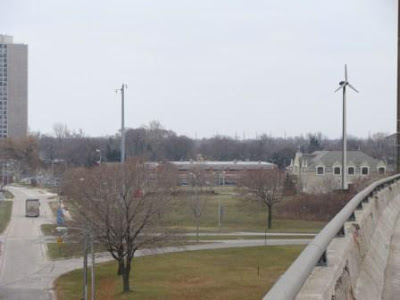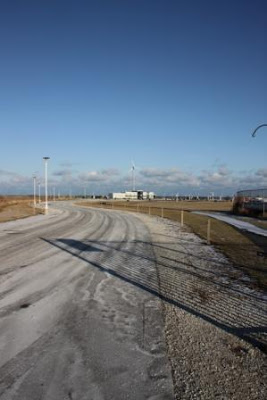by jboullion | Jan 18, 2011 | Uncategorized
From a commentary by by Keith Reopelle, Senior Policy Director of Clean Wisconsin:
MADISON — A special session bill recently proposed by Governor Scott Walker includes many provisions that could hurt Wisconsin’s economy and environment, but one of the most perplexing proposals in this package is a new regulation that would effectively ban wind energy projects in Wisconsin.
The regulatory reform bill proposed by Gov. Walker would close Wisconsin’s doors to clean, renewable wind power and cost our state thousands of jobs. Our state legislators – who were elected on the promise of real job creation and economic recovery – should reject Gov. Walker’s bill.
The proposed bill creates regulations that effectively prohibit wind energy developers from constructing a wind turbine within 1,800 feet of the nearest property line. If approved, this law will make siting a wind farm so difficult that no wind developer will even bother trying; especially when Illinois and Iowa are waiting with open arms, having no setback provision at all.
The bill will immediately jeopardize 11 proposed wind projects that are set to create hundreds of jobs and undoubtedly many others in the planning stages.
Beyond killing current projects, this law would ensure that no new wind development companies or wind turbine manufacturers locate in Wisconsin, and result in the loss of thousands more jobs constructing and maintaining wind turbines.
Wind energy production is one of the world’s fastest growing industries. In 2010, the industry employed over 85,000 people nationally. In Wisconsin, the wind industry supports thousands of jobs at businesses like Tower Tech in Manitowoc and Renewegy in Oshkosh. Both companies produce parts for wind turbines. Tower Tech produced its first turbine in 2005 and now employs over 250 people at its plant where it offers competitive wages and good benefits.
By effectively banning wind energy construction in the state, this law would leave manufacturing companies like Tower Tech with far less incentive to develop in Wisconsin.
These more restrictive regulations would replace rules that the Wisconsin Public Service Commission (PSC) recently approved after two years of study, six rounds of public comments, and input from all major stakeholder groups.
by jboullion | Jan 17, 2011 | Uncategorized
From a news release issued by the Wisconsin League of Conservation Voters:
Illinois Stands to Benefit from Walker’s Excessive Wind Regulations
Madison – Just days after appearing on TV and radio in Chicago to remind Illinois that Wisconsin is open for business, Governor Walker introduced a bill that would essentially ban wind development in Wisconsin. The move would leave Wisconsin dependent on other states, including Illinois, to meet our energy demand.
In the bill introduced for consideration in the special session, Governor Walker suggests placing regulations on wind development that are so restrictive, they would essentially prohibit the development
of future wind projects in Wisconsin, and even stop some already on the docket. If passed, it’s estimated that Wisconsin will immediately lose $1.8 billion in new wind power investments and jeopardize eleven currently proposed wind projects. Illinois has no restrictions on wind siting.
Wisconsin currently ranks fifth in the nation in the portion of its electricity derived from imported coal. Wisconsin sends more than $850 million out of state every year to places like Indiana, Wyoming, and Illinois to purchase coal.
“While other states are moving forward with their own energy independence, it appears Governor Walker wants Wisconsin to remain dependent on places like Illinois for our dirty coal habit. This move is sending a very dangerous message to the global wind industry. From those who install wind turbines to those who manufacture them, Governor Walker is suggesting they take their business elsewhere,” said Kerry Schumann, Executive Director of Wisconsin League of Conservation Voters.
There is growing concern that Governor Walker’s rejection of twenty-first century energy projects is becoming a pattern.
by jboullion | Jan 14, 2011 | Uncategorized
From an article by Tom Content in the Milwaukee Journal Sentinel:
More than 160 people got their first glimpse Thursday of what a city wind turbine development near the Port of Milwaukee would look like.
A packed house at the South Shore Park Pavilion took a look at the renderings. Some asked questions about the project, its cost, and the noise the turbines would generate, among other concerns.
The city’s Office of Environmental Sustainability is proposing the project to make a statement in support of renewable energy and to tap greener sources of electricity for the Port of Milwaukee’s administration building.
The turbines would be either 115 or 156 feet tall, depending on the model selected. That’s less than half as tall as the utility-scale turbines built in recent years by We Energies and Invenergy in Fond du Lac and Dodge counties.
Ken Szallai, president of the Lake Express Ferry, said the city should consider making a broader statement toward sustainability that could incorporate solar power and informational exhibits, potentially at the Lake Express terminal that the city owns.
He said he shares concerns about how noisy the turbines would be, and is worried that the turbines could harm migratory birds.
“This is one of the premier places in the state to look at waterfowl and other migratory birds,” he said.
Residents at the meeting were mixed in their views. Some raised questions about whether the project is a worthwhile use of taxpayer money. The maximum project cost, $400,000, would be financed through a federal renewable-energy and energy-efficiency grant.
But that’s still taxpayer money, said Sharon Murphy, a 25-year resident of Bay View Terrace.
“That grant is a federal grant,” she said. “It’s our money!”
Bay View resident Dianne Sinnwell prompted cheers when she said she favored the plan. “We have an opportunity to be a leader in environmental clean energy, and we ought to take advantage of this opportunity,” she said.

by jboullion | Jan 13, 2011 | Uncategorized
From an article by Tom Content of the Journal Sentinel:
The city’s Office of Environmental Sustainability has released renderings of what a proposed wind turbine near the Port Administration building would look like.
Here are two views, showing one of each turbine. It’s not an apples-to-apples comparison because they are shown at two different sites, one by the port building and one closer to the lakeshore near the Lake Express ferry terminal. The renderings were prepared by the University of WIsconsin-Milwaukee Institute for Ecological Design.
The first shows the smaller turbine, a 20-kilowatt tower standing 115 feet tall. designed by Renewegy of Oshkosh, by the Port Administration building:
Below is a view of the North Power 100, built by Vermont-based Northern Power Systems, near the Lake Express terminal. It’s a 100-kilowatt turbine that would be 156 feet tall at the tip of the wind turbine blade.
A community meeting to discuss the possible placement of turbines at one of the two sites is planned for 6 p.m. Thursday at South Shore Park Pavilion.
by jboullion | Jan 12, 2011 | Uncategorized
From an article by Colleen Kottke in the Fond du Lac Reporter:
Local municipalities are profiting from the wind. While many residents in Fond du Lac and Dodge counties live nowhere near the turbines dotting the landscape, the revenue stream from the towering towers is helping to offset increases in property taxes.
Last year, owners of Wisconsin’s four largest wind energy projects paid out nearly $2.8 million in rent to landowners hosting turbines and payments in lieu of property taxes to local governments, according to figures compiled by RENEW Wisconsin, a statewide renewable energy advocacy organization.
Fond du Lac County, which is home to 166 wind turbines, received a revenue payment of $625,000. Dodge County received $296,000 in payments for hosting 85 wind turbines.
“While we didn’t designate the income for anything in particular, we did use it to pay the bills of the county. Ultimately, it saves on property tax,” said Fond du Lac County Executive Allen Buechel.
Formula
Towns and counties do not collect property taxes from wind turbines but instead receive payments based on the generating capacity of each turbine, allocated under a formula adopted by the state Legislature in 2003.
Of the total revenue paid out to local governmental entities, counties retain two-thirds of the payments while townships hosting the turbines receive one-third. Payments to those local governments in Fond du Lac and Dodge counties will reach almost $1.6 million for 2010.
Wind energy developers negotiate lease agreements with landowners to host turbines on their property. Payments can be as high as $7,000 per turbine each year. Estimated rental payments to all Fond du Lac and Dodge county landowners will total slightly more than $1.2 million for 2010. Property owners hosting the 88 wind turbines in the Blue Sky Green Field wind farm in townships of Marshfield and Calumet divvied up a total of $440,000 paid to them by WeEnergies.
Marshfield Township Chairman John Bord said the $121,000 received from WeEnergies was used to keep rising property taxes in check in the town.


